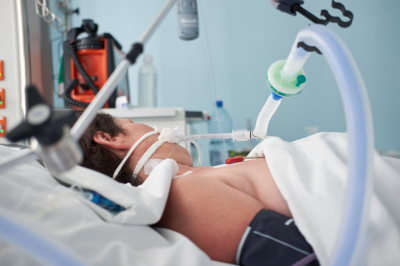The Fitness Zone

Research Review: Can exercise really save your life from COVID?
A large-scale study explores the relationship between exercise habits and severity of health impacts in COVID-19 patients.
Review by Assoc Prof Mike Climstein PhD & Dr Joe Walsh PhD.
KEY POINTS
- The Centers for Disease Control and Prevention in the US has documented that advanced age, gender (males) and certain chronic diseases are recognised risk factors for severe COVID-19
- Researchers set out to identify whether there was a relationship between levels of physical activity and risk of severe COVID-19 complications or death
- The study involved over 48,000 participants aged 18 years and older with a positive COVID-19 diagnosis
- Inactive individuals were over three times as likely to be hospitalised from COVID-19, almost three times as likely to be admitted to an intensive care unit, and six times more likely to die from COVID-19
Title: Physical inactivity is associated with a higher risk for severe COVID-19 Outcomes
Authors: Dr. Sallis and colleagues (Dept of Family and Sports Medicine, California USA)
Source: British Journal of Sports Medicine. Available free online at https://bjsm.bmj.com/content/early/2021/04/07/bjsports-2021-104080#F1
Preamble: We would like to thank our Research Review readers who provided feedback on our Autumn 2021 Research Review on exercising while wearing a facemask. It was quite interesting to hear from so many of you that had experienced similar feelings of restricted breathing while wearing a mask, particularly during high intensity aerobic exercise. Most importantly, you kept yourselves safe, protected other exercise enthusiasts and were completing exercise for both fitness and mental health benefits. And this takes us into this issue’s Research Review, which involves those that were not exercising and their increased risk of severe COVID-19.

Introduction: There is a large cohort of us ageing fitness fanatics who continually attempt to defy the steady march of time and maintain our once youthful strength and fitness through continual, high-intensity, scientific, evidence-based training regimes. During the pandemic closures of gyms and fitness facilities in NSW and QLD, I was fortunate to have access, albeit somewhat restricted, to strength and cardio training equipment. Many friends and colleagues, however, were not so fortunate and went to the dark side of being sedentary for months due to COVID restrictions and a lack of access to alternative training means.
But what about the Homer Simpsons and other individuals who avoid any form of exercise or physical activity? Well, it turns out this group of couch potatoes is associated with a much higher risk of severe COVID-19 compared to fitness enthusiasts – at least according to Professor Sallis and his colleagues’ recent publication, the focus of this Research Review. Sallis and his team studied data from the Kaiser Permanente Medical Center in the US, a healthcare system which serves approximately 5 million residents in Southern California.
“What about the Homer Simpsons and other individuals who avoid any form of exercise or physical activity?”
The Centers for Disease Control and Prevention, generally just referred to as the CDC, is the United States national health protection agency, whose mission it is to protect public health, and save lives by tracking health and disease trends, such as COVID-19. The CDC has documented that advanced age, gender (males) and the presence of certain chronic diseases such as diabetes, obesity and cardiovascular disease, are well recognised risk factors for severe COVID-19. However, Clinical Professor Sallis (an eminent sports medicine doctor) and colleagues set out to identify whether there was a relationship between levels of physical activity and risk of developing severe COVID-19 complications or death.
Method: The researchers conducted a study involving over 48,000 participants who were aged 18 years and older with a positive COVID-19 diagnosis between January 2020 and October 2020.
Exercise vital signs (EVS), is used with every outpatient at Kaiser Permanente Medical Center. EVS involves asking and recording the answers to two questions about the patient’s typical exercise habits over the previous two months. For example, on average, how many days per week do you engage in moderate to strenuous exercise (0 to 7 days per week). And if they do complete moderate to strenuous exercise, how many minutes at that level (0, 10, 20, 30, 40, 50, 60, 90, 120 and 150 minutes or greater). From the participants’ responses, they were separated into the following categories; EVS > 150mins/wk (which meets current physical activity/exercise guidelines); EVS 11 to 149 minutes per week; and those deemed inactive with EVS 0 to 10 minutes per week.
Results: Data from a total of 103,337 individuals was used in this study. Of this number, 48,440 participants, which is approximately 47%, were either hospitalised, admitted to an intensive care unit, or deceased due to COVID-19. Staggering numbers for sure. Of those participants, only 6.4% were meeting the physical activity guidelines (i.e., EVS > 150 minutes per week) and 14.4% were inactive (i.e., EVS 0 to 10 minutes per week). However, it is quite interesting to observe the differences in the EVS categories with regard to COVID-19 hospitalisations and death (Table 1).
TABLE: ACTIVITY LEVELS VS HEALTH OUTCOMES IN COVID-19 PATIENTS
| Consistently inactive (~ 7,000 participants) | Some activity (~ 38,000 participants) | Meeting current physical activity guidelines (~3,100 participants) | |
| Hospitalisation | 10.5% | 8.9% | 3.2% |
| Admitted to ICU | 2.8% | 2.5% | 1.0% |
| Deceased | 2.4% | 1.5% | 0.4% |
As you can see, compared to those who met current physical activity guidelines, individuals who were inactive were over three times as likely to be hospitalised from COVID-19, almost three times as likely to be admitted to an intensive care unit, and six times more likely to die from COVID-19!
“Individuals with COVID-19 that met recommended physical activity guidelines had a reduced risk for hospitalisation, admission to an intensive care unit or death.”

The authors concluded that if individuals with COVID-19 were meeting the recommended physical activity guidelines of > 150 minutes per week, there was a reduced risk for hospitalisation, admission to an intensive care unit or death.
Pros: This is a large-scale study which demonstrates the profound benefits associated with previous exercise history in terms of improved outcomes from COVID-19 patients. Additionally, those that did ‘some physical activity’ still had some associated benefit with regard to hospitalisation, intensive care admission and death. Given COVID-19 will continue to affect life around the world, this study has significant and wide implications for regularly participating in physical activity.
“Given COVID-19 will continue to affect life around the world, this study has significant and wide implications for regularly participating in physical activity.”
Cons: As flagged by the author’s themselves, it would have been good if the EVS data collected was not self-reported data, which tends to be unreliable. It would also have been beneficial for the collected EVS data to include more information, such as details about the types of exercise completed, i.e. resistance or aerobic training. It may then have been possible to identify whether a certain type of training provided greater benefits to those who go on to contract COVID-19.
REFERENCES
Sallis, R., Young D., Tartof, S., Sallis, J., Sall, J., Li, Q., Smith, G., & Cohen, D. (2021). Physical inactivity is associated with a higher risk for severe COVID-19 outcomes: a study in 48 440 adult patients. British Journal of Sports Medicine.
Assoc Prof Mike Climstein, PhD FASMF FACSM FAAESS AEP
Dr Climstein is one of Australia’s leading Accredited Exercise Physiologists. He is a faculty member in Clinical Exercise Physiology, Sport & Exercise Science at Southern Cross University (Gold Coast). michael.climstein@scu.edu.au
Dr Joe Walsh, PhD
Joe has worked in a number of large international research teams with study findings presented around the world. In addition to working in the university sector, he is a director of Sport Science Institute. sportscienceinstitute.com
Read more articles
Disclaimer: Where Certificate III in Fitness, Cert III/Cert 3, or Fitness Coach is mentioned, it refers to SIS30321 Certificate III in Fitness. Where Certificate IV in Fitness, Cert IV/Cert 4, or Personal Trainer is mentioned, it refers to SIS40221 Certificate IV in Fitness. Where Master Trainer Program™ is mentioned, it refers to Fitness Essentials and SIS40221 Certificate IV in Fitness. Where Master Trainer Plus+ Program™ is mentioned, it refers to SIS30321 Certificate III in Fitness and SIS40221 Certificate IV in Fitness. Where Certificate IV in Massage or Cert IV/Cert 4 is mentioned, it refers to HLT42021 Certificate IV in Massage Therapy. Where Diploma of Remedial Massage is mentioned, it refers to HLT52021 Diploma of Remedial Massage.











